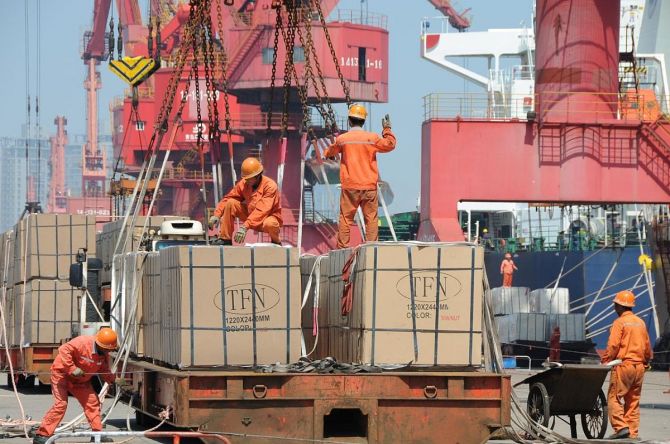Exports to China saw sustained double-digit growth for the fourth straight month in August, led by eightfold rise in iron and steel shipments.

India’s robust double-digit exports growth to China, coupled with sharp contraction in imports, nearly halved the trade gap between the two trading partners in the first five months of the current fiscal year (2020-21, or FY21) over the same period of 2019-20 (FY20).
The restriction on imports from China, along with the Atmanirbhar Bharat campaign, has shrunk India’s trade deficit with the neighbouring country to $12.6 billion between April and August of FY21, from $22.6 billion in the year-ago period.
India’s trade deficit with China stood at $23.5 billion in the corresponding period of 2018-19 and at $26.33 billion in 2017-18.
Exports to China saw sustained double-digit growth for the fourth straight month in August, led by eightfold rise in iron and steel shipments.
In the April-August period, outbound shipments to Beijing expanded 27 per cent, compared to 9.5-per cent expansion in the same period last year.
Imports contracted 27 per cent in the first five months to $21.5 billion and shrunk 21 per cent in August alone.
India’s exports to China grew 15 per cent in August, with shipments worth $1.68 billion, revealed the data by the Department of Commerce.
Exports growth to Beijing peaked in June at 78 per cent and expanded 48 per cent in May and 23 per cent in July.
India’s exports basket to China mainly accounted for iron and steel, which rose 833 per cent to $1.8 billion till August this year, compared with $192 million last year.
China accounted for 35 per cent of India’s iron and steel outbound shipments in the first five months of the fiscal year, against 5.3 per cent in the corresponding period last year.
China also made up for 90 per cent of India’s exports of iron ore worth $1.6 billion, a fourth of exports of organic chemicals worth $809 million, and 16 per cent of exports of marine products worth $351 million during the five months.
The import basket is largely dominated by telecom instruments, organic chemicals, and industrial equipment for dairy, etc.
Biswajit Dhar, professor, Jawaharlal Nehru University, said that exports to China have grown on account of two reasons.
First, it is the only economy that is growing, while others are contracting.
Second, there will be some diversion of exports from other destinations to China.
Dhar said this narrowing of trade deficit may not be sustainable.
Domestic demand is currently squeezed, which explains the lower imports.
“Doing away with the dependence on China for critical items like active pharmaceutical ingredients may not happen overnight, but will take years and require medium-term strategy,” he added.
In FY20, exports to China were down 0.83 per cent at $16.6 billion, accounting for 5.3 per cent of total outbound shipments.
For this fiscal year, China accounts for 9.1 per cent of India’s total exports till August, behind US at 17 per cent.
The United Arab Emirates (UAE) has been displaced to the third largest export destination for India this fiscal year, accounting for 5.29 per cent of total outbound shipments.
Arpita Mukherjee, professor, Indian Council for Research on International Economic Relations, also pointed out that the artificial import restrictions may not really work - it simply results in rerouting of items from other markets like Hong Kong or the Association of Southeast Asian Nations.
She, however, added that China has also been putting in efforts to narrow the trade deficit gap with India and buying ayurvedic products and health supplements.
“China is trying to be accommodative to India to narrow the trade deficit. It seems to be directly sourcing items from India,” said Mukherjee.
Among India’s top five export partners, China is the only destination showing growth.
Exports to the US are down 24.6 per cent. In the case of UAE, they are down 59.2 per cent.
Shipments to Singapore also contracted 24.2 per cent and 26.7 per cent, respectively.
Incidentally, China’s exports continued to expand in August, growing 9.5 per cent.
In absolute terms, it was at the third-highest level ever exported by the country in a month at $235.3 billion on account of sustained demand for medical equipment and electronic items.
Photograph: Tyrone Siu/Reuters












 © 2025
© 2025